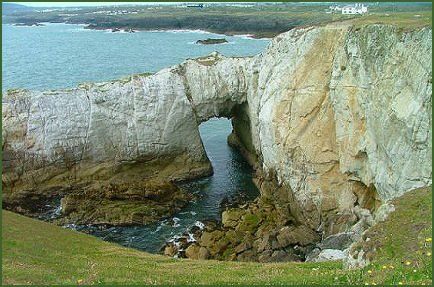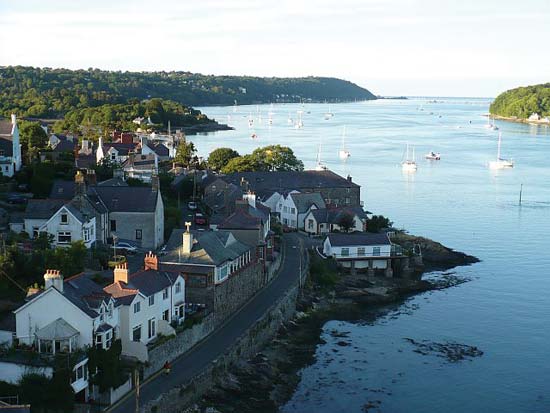
Anglesey. An island off the North West Coast of Wales. Known for it’s varied, changeable and challenging sea conditions and therefore a mecca for sea kayakers. And so, early on 6th June, l left the campsite near St Davids, Pembrokeshire where I’d spent the previous week kayaking and headed north. Anglesey Outdoors, an outdoor activity centre and camp site (01407 769351) was my destination.
That was to be my base for the following week because in a moment of enthusiasm or perhaps madness some months earlier, I’d signed up to five days of what was advertised as a ‘Rough water week’ with Kayak Essentials (info@kayakessentials.co.uk) followed by two days of ‘Dynamic Water’ with Sea Kayaking Wales (info@seakayakingwales.com)
Having settled in I went for a walk to Porth Dafarch where by chance I bumped into Nick Cunliffe, one half of Kayak Essentials and his wife Kelly. I’d paddled with Nick a couple of times before. He is, without doubt, one of the top sea kayak coaches in the UK. Kelly, a petite American, was more used to kayaking in the surf in California and almost considered paddling three miles along the coast of Anglesey an expedition! At the briefing the next morning we were met by our third coach Zoe Newsam (zoenewsamcoaching.co.uk) whom I’d also previously paddled with. South Stack, a small island off the West Coast of Anglesey was our destination for the day. We launched from Porth Dafarch. Although South Stack was not too far to paddle, it did entail a short encounter with the tide races at Penrhyn Mawr. The plan, given the high-water times, was to head to South Stack and paddle in the tide races there. That way we’d paddle there and back with the incoming then outgoing tide.
Tide races, for those unfamiliar with them, are formed where the tidal flow is effectively squeezed through a constriction resulting in the formation of waves, eddies and indeed hazardous currents. The severity of these conditions is weather and tide related. Penrhyn Mawr tide race for example, because of the shape of the coast, only forms of the incoming tide. A faster flow (spring tides) results in far more water movement and therefore more challenging conditions. Tide races also occur when the water simply flows fast around a headland (as at South Stack) caused by headland shape or the varying underlying sea floor heights or indeed any combination of these conditions.
How does paddling in a tide race work? In this instance (Penrhyn Mawr) the flow is going south to north. The inner race is where the water is being squeezed between the coastal cliff face and some small rocky islands just off shore. Behind these rocks are eddies with very little water movement and therefore safe places to perhaps regroup and rest. Beyond the islands are the outer races, often much more turbulent and challenging.
What is the object of paddling in a tide race? Having paddled through the tide race with the flow, it’s a matter of turning around and heading back against the flow and surf the northbound, often standing waves. The reality is, although the water itself is heading north, the waves remain in one place, because it’s the energy within the water that cause the wave. With practice and skill (of which I have in limited supply), it’s possible to pick up a wave and do almost nothing to stay riding it.
Being swept backwards into the likely unknown/bigger waves or the kayak veering off to the left or right usually needs some swift and decisive paddling, hard into the flow to calmer water then back through the tide race to do it all over again.
If conditions are so challenging, why would anyone want to be in them, let alone keep going back into them time and time again?
Undoubtedly boat handling and paddling skills, along with paddler confidence are dramatically improved.The tide race and general conditions off South Stack were exactly what you’d expect on a Rough Water Week. To describe it as ‘lumpy’ is an understatement. The eddy lines between the eddies and the faster flowing water were less defined than at Penrhyn Mawr but wave height, wave steepness, the speed of the tidal flow, and the fact many waves were breaking, made for a most entertaining session.
Tuesday saw us launch from Holyhead beach then paddle to North Stack, an island off the North West Coast of Anglesey onto South Stack.
The morning sessions was all about breaking in and out of tide races, boat handling skills and in my case, swimming. The afternoon was all about rough water which, much to my surprise, I felt comfortable paddling in. How rough? Rough enough that when I was in a trough between waves, everyone else disappeared!
Wednesday saw us launch at Rhoscolyn, a small beach on the west coast reached via the narrowest of roads with perhaps the most expensive car park in the world. The plan was to journey northward to Porth Dafarch, which involved a vehicle shuttle but was well worth the effort.
Looking out from the bay beyond Rhoscolyn beacon the seas were, as my diary says, huge, some of which were, not surprisingly, breaking. Winds were force 5 to 7 from the west.
After a warm up in the sheltered bay we were off. Heading to the small islands just outside the bay any shelter the bay or the island at the wide entrance offered vanished in an instant. It was wild! My best guess is the waves were at least two meters high. Some broke over the bow of the kayak resulting in a face full of water. Some broke side on. Others broke just as they passed under the boat. A lot of those that didn’t break simply disappeared under the boat as I paddled through, often leaving the front end from the cockpit forward to slap down onto the water again.
After a circumnavigation of the small islands off Rhoscolyn and a short breather tucked in an eddy, the journey began in earnest. It was simply cracking fun. Not everyone’s idea of fun I know, but I was enjoying myself. That’s not to say I didn’t have a near miss or two. On a few occasions I was nothing more than a low brace or a well-placed paddle stroke away from swimming.
Other times, seeing a wave was about to break from the side, I’d have to brace into it and lean in whilst all the time being pushed sideways.
Looking back on that day, given the conditions and the length of time we were in them, I’d say that was my best paddle ever. Again, referring to notes in my diary, it simply says ‘Brilliant day’, which sums it up nicely.
Thursday was spent on the Menai Straits, a stretch of water that separates Anglesey from the mainland, known in the kayak world for its fast-moving waters. The morning was spent in the tide races in and around the Britannia Bridge and the Menai Suspension bridges. The afternoon was devoted to a ‘play’ in The Swellies, an area of more open yet rapidly moving water with some overalls followed by, for those that fancied it, a bit of rolling practice.
Friday, the last day with Kayak Essentials, was spent in yet more challenging water, this time having launched from Cemaes Bay on the north Anglesey coast. More huge swells and breaking waves to keep us entertained and, unbelievably quickly, the day, and indeed the five days, were over.
The next day, bright and early, I met with Paul and Merco, the two Sea Kayaking Wales leaders. Paul, I knew from Pembrokeshire. I joined with a group of eight paddlers and having launched at Porth Dafarch we headed north along the coast to North Stack and, as was expected, spent time in the tide races at Penrhyn Mawr, which seemed to me to be bigger and more challenging than my visit a few days earlier.
After lunch, on the return trip, far off in the distance, could be seen and indeed heard what could only be described as a wall of white water. As we faced it, to the left end was North Stack and the lighthouse, the right end seemingly well out to sea. We were paddling on an ebbing tide and within no time were a few hundred metres from it. Merco briefed us. Never let it be said Germans don’t have a sense of humour! The plan was to turn around and let the flow take us backwards into the heaving mass of water, pick up what waves we could, and surf them.
In what seemed like seconds, the much smaller, green waves were under us. Having practiced my surfing skills (with limited success) I knew at least the theory, to chase the last wave that had passed under me, just as the bow of my kayak began to rise again, lean forward, look where you wanted to go and paddle hard.
To my surprise, my early attempts were a relative success. Surely time for tea and medals? Not quite! The problem was, with each manageable green wave that passed under me, whether I’d managed to surf it or not, with the flow of the tide taking me ever backwards, the nearer I was to the huge breaking waves behind. In no time at all the mass of water that had seconds before been behind was all about me. With the waves crashing all around, time and again I was lifted up and, whether I wanted to be or not, was hurtled forward and downward into the trough.
When this happened, all I could see was water and sky. All I could hear was breaking waves crashing around me. If I’d been any good I probably would have had a view of North Stack and the lighthouse off to my right but in the event, I thought better of it and concentrated on the job in hand.
I tried paddling forward into the flow to where the green water was or at least to where the slightly smaller waves were. I managed to, with limited success, but was soon back in the big stuff which I knew I’d struggle even more to control the kayak in, let alone surf.
In what seemed like an eternity, using a combination of kayaking skills and a fair heap of good luck, I managed to stay upright and to my mind at least, put in a display of someone who knew what he was doing!
The waters around Anglesey being what they are, within a very short space of time, the waves subsided to nothing more than a modest swell and we continued our paddle back to Porth Dafarch.
By lunch time the following day, with the weather and seas very much calmer, we found ourselves on a stony beach in the shadow of the now decommissioned Wylfa nuclear power station, just west of Cemaes Bay. The sun was shining and, having eaten my lunch and finished off my lukewarm tea, I laid down, resting my head on a rock.
Lunch over, it was time for one more tide race, about 200 metres off shore which, in comparison with anything we’d encountered during the week, was decidedly benign.
Twenty minutes later and it was over. We had a gentle paddle back to Cemaes Bay for a debrief and goodbyes.
Looking back over the month, what amazed me more than anything, was the time had disappeared so quickly. Had I enjoyed the whole experience? Yes, immensely. I’d met some lovely people, had some real laughs and enjoyed some spectacular and often challenging kayaking. Would I do it again? Certainly. What had I gained? I don’t think it’s possible to experience such varied conditions with such a diverse group of paddlers, led by such professional and dedicated leaders and not return home a vastly more informed and capable paddler.
What’s next? August, I’m back in Anglesey for another Dynamic Water weekend followed by a weekend paddling in Dorset, somewhere along the Jurassic coast with friends I’ve met on my travels.
Thanks to everyone I’ve met along the way, for your help, encouragement and laughs. I couldn’t have done it without you.
Thanks dear reader, for taking the time to get this far.
Roger







